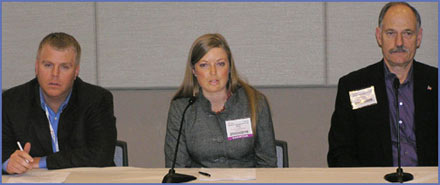Panel Discussion Finds Little Upside to COOL
PHOENIX, Ariz. (Jan. 30, 2009) — Mandatory country-of-origin labeling (COOL) got a chilly reception during a panel discussion Thursday at the Cattle Industry Annual Convention & NCBA Trade Show in Phoenix.
The forum was part of the annual meeting of the Livestock Marketing Council, a group consisting mainly of livestock auction market operators and cattle buyers from across the nation. Panelists included U.S. Meat Export Federation (USMEF) Economist Erin Daley, as well as National Meat Association chief executive officer (CEO) Barry Carpenter and Cody Easterday, a cattle feeder from Pasco, Wash.
Daley addressed the effects of COOL on live-cattle trade and the potential problems the issue could create in the U.S.-Canada-Mexico trade relationship. She said Mexico and Canada combined to account for about $2 billion in U.S. beef export purchases last year — about 60% of the worldwide 2008 total. Any disruption in trade could have serious consequences for U.S. cattle producers.
 USMEF Economist Erin Daley (center) is joined on a panel by cattle feeder Cody Easterday (left) and National Meat Association CEO Barry Carpenter.
USMEF Economist Erin Daley (center) is joined on a panel by cattle feeder Cody Easterday (left) and National Meat Association CEO Barry Carpenter.
“CattleFax estimates that, at the very least, it will cost cattle producers $50 to $60 per head if we lose the NAFTA export markets,” Daley said. “In addition to the large volume of variety meats that we export to Mexico, rounds are a very popular item in that market. Rounds also make up a large portion of our exports to eastern Canada. It would be very hard to absorb these products into the domestic market.”
Daley said the U.S. processing industry will have even more excess capacity if live-cattle imports from Canada and Mexico continue to decline. This drags down the industry’s level of efficiency, making it more difficult for U.S. beef to compete in global markets with exports from countries such as Australia and Brazil.
Daley said the “mixed origin” label required under COOL also creates difficulties for U.S. beef exports because it is not accepted by any major trading partners.
“Mixed-origin meat simply can’t be exported, not even back to Canada,” she said. “We have enough hurdles and obstacles that already interrupt trade. Why create one more?”
Easterday said COOL is causing major problems for cattle producers in the Northwest, especially the segregation requirements for cattle at the point of slaughter.
“Sometimes our feedyard might be 30% to 40% Canadian cattle, but sometimes it’s zero,” he said. “If packers have to set aside certain days for killing Canadian cattle, that kind of seasonality creates major problems.”
Carpenter agreed the major drawback of COOL is not with the labeling, but with the segregation of cattle. He said COOL adds significant production costs, “without any recognizable benefits.”
Carpenter said the final COOL rule, which is set to take effect March 16, is designed to minimize the amount of segregation required at slaughter. But it is still unclear if the final rule will take effect as scheduled, or if it will be delayed for further review and revision by the Obama administration. Carpenter is hopeful the final rule will move forward, as he sees little benefit to extending the process.
“If comments on COOL are reopened, USDA is not going to hear anything new,” he said. “It’s just going to be the same parties making the same arguments about the same issues.”
Bill Thomas, a cow-calf and stocker operator attending from Sacramento, Calif., said the forum was the most realistic discussion he has ever heard on COOL.
“Thank you for that,” he said. “I agree this is just going to be a collection of negatives.”
Bill Jameson, a cattle feeder and cattle buyer from Moose Jaw, Sask., said cattle producers will pay a severe price for COOL on both sides of the border.
“This is the worst thing that’s ever happened to the North American cattle industry,” he said. “If our Canadian cattle end up getting sold at a discount, yours will too.”
Easterday agreed with Jameson’s prediction, because he does not think consumers will find a distinction between U.S. meat and meat of mixed origin. He feels they are very unlikely to pay a premium based solely on country of origin.
“Once a customer buys that (mixed origin) meat at a discount and it tastes the same, how will you ever get them back?” Easterday asked.
Editor’s Note: This article was provided as a news release by the U.S. Meat Export Federation. For more information contact Jim Herlihy, vice president of information services, at 303-623-6328 or visit USMEF's newsroom at www.USMEF.org.
The U.S. Meat Export Federation is the trade association responsible for developing international markets for the U.S. red meat industry and is funded by USDA, exporting companies, and the beef, pork, corn and soybean checkoff programs.

